This article is a condensed guide to the numerous and diverse cultures and peoples living in the Known World, across the three known continents of Westeros, Essos, and Sothoryos. It is a navigation portal, meant to give a brief description of each group and its relationship to other groups, but more extensive information can be found by following the links to the main article devoted to each.
The dividing line between "ancient" cultures and peoples and "contemporary" ones in this article is defined as before or after the Targaryen Conquest of the Seven Kingdoms, which took place three hundred years before the War of the Five Kings. The last major migration to Westeros was made by the Rhoynar, about seven hundred years before the Targaryen Conquest (the Targaryens themselves were Valyrians but their numbers were so few that they did not have a significant impact on the continent's overall ethnic makeup). The cultures of the Free Cities and other lands of Essos in the present were largely shaped by the Doom of Valyria, which occurred one century before the Targaryen Conquest, during which the Valyrian Freehold collapsed and its surviving colonies reformed into independent city-states and realms.
Therefore, the Targaryen Conquest makes a convenient cutoff point (it is also used to mark Year 1 of the dating system used in Westeros). Some of the "ancient" cultures, however, simply evolved into modern ones gradually: the Andals who invaded the Westerlands 6,000 years ago initially formed many small petty kingdoms, and only coalesced into the "Kingdom of the Rock" many centuries later. Yet by the time of the Targaryen Conquest, they had been unified under their own Lannister kings, and had thought of themselves as "Westermen", for many centuries. Still, for the purposes of the Game of Thrones TV series, this provides a fairly reliable break between "ancient" and "contemporary" or ("modern") cultures and peoples.
Ancient Cultures and Peoples of Westeros
First Men
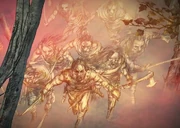
The First Men arrived in Westeros 12,000 years ago.
The First Men are the original human inhabitants of Westeros, who first migrated to the continent 12,000 years ago. They ruled the continent for millennia before the Andals invaded from the eastern continent of Essos. The Andals overran most of southern Westeros, but failed to take the North. While the blood of the First Men and the Andals has intermingled over thousands of years of dynastic marriages, the inhabitants of the North have the greatest amount of First Men blood in their veins and keep their traditions.[1][2]
- To be clear: the "First Men" are not the first humans who lived in the entire world. Humans were already living on the eastern continent of Essos for untold millennia (and probably also on Sothoryos, the Africa-like continent south of Essos). The exact origins of the human race are not known, because just as in real life, written history does not extend that far back. Even oral history eventually fades into varying fables, legends, and religious explanations for the origins of humans. The "First Men" are simply the first humans that migrated to the western continent of Westeros.
Andals
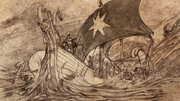
The Andals crossed the Narrow Sea to invade Westeros 6,000 years ago.
The Andals are a race of men who invaded Westeros six thousand years prior to the events of the series. In the present day, they are the dominant ethnic and cultural group in the continent.
The original homeland of the Andals is a region on the west coast of Essos which was called Andalos, located north of the modern Free City of Pentos, across the Narrow Sea from Westeros. Six thousand years ago, after allegedly receiving visions from the "Seven-faced God", the Andals were spurred on by their new Faith to migrate to Westeros, where they overran and conquered most of the continent, then inhabited by the First Men. The Andals brought the concept of chivalry and iron-wrought weapons and armor with them from Essos.
In many cases the Andals did intermarry with the First Men they conquered, so that even House Lannister claims at least some minor descent from the First Men. Still, the overwhelming influence on the bloodlines of the continent are from the Andals, to the point that the Seven Kingdoms are often called "the Land of the Andals" by peoples in Essos (such as the Dothraki).
The exceptions are the North, which the Andals never conquered and where the blood of the First Men is still strong, and Dorne, where the Andal inhabitants later intermingled with the refugees from the east.[2]
Ironborn

The ancient ironborn branched off from the First Men, and the Andals who later invaded the isles simply adopted local ironborn culture.
The ironborn[3] (or rarely, ironmen) are the natives of the Iron Islands off the west coast of Westeros. They are a fiercely independent seafaring people who chafe at the rule of the Iron Throne.
The ancient ironborn were apparently First Men who colonized the islands, but their culture radically diverged from their cousins on the mainland. The modern ironborn are an intermingling of the blood of the original First Men settlers of the islands and the Andals who followed six thousand years later. While the Andals and the Faith of the Seven came to dominate everywhere else below the Neck, they found less purchase on the Islands. While a few converts to the Faith of the Seven may be found there even in the present day, most of the Andal invaders converted to the native deity, the Drowned God, instead. The Andal invaders completely acculturated to the distinct "ironborn" culture, and their invasion had relatively little impact upon the Iron Islands.
Thus the ironborn are ethnically composed of the same First Men/Andal mix as most of the rest of Westeros: they are culturally, not ethnically distinct. Even so, their culture developed so radically differently from societies on the mainland that the ironborn essentially form the fourth major cultural group in Westeros, besides the First Men, Andals, and Rhoynar.
One of the few notable changes was that the ironborn switched to speaking the Common Tongue of the Andals. On the other hand, the independent First Men of the North also eventually took up using the language of their Andal neighbors through cultural proximity, not because it was imposed upon them, and therefore it might be wrong to say that the Andals even "forced" the ironborn to speak their language.
Rhoynar
The Rhoynar were a people from the eastern continent who fled to Dorne one thousand years ago, after losing a series of massive wars with the Valyrian Freehold. They intermingled with the local First Men and Andal inhabitants.
Dornishmen are descendants of the Rhoynar and still keep some of their customs and laws alive.
Ancient Cultures and Peoples of Essos
Ghiscari

Thousands of slaves toiled to build the pyramids of the ancient Ghiscari Empire.
The Ghiscari Empire was one of the oldest - if not the oldest - civilizations known to have existed. It ruled much of the continent of Essos, centered around the region known as Slaver's Bay. It was already thriving and building vast cities with massive pyramids when the Valyrians were still humble shepherds tending their flocks on hillsides. Like the Valyrians, the Ghiscari extensively practiced slavery, refining it into a well-developed discipline. While the Valyrians rode dragons into battle, the Ghiscari fielded vast lock-step legions of slave-soldiers.
After the Valyrians discovered and learned to ride dragons as beasts of war, they began their own expansion, and eventually came into conflict with the Ghiscari Empire. The Valyrian Freehold and Ghiscari Empire fought a series of five great wars, contesting which would be the dominant power in Essos. At the end of the last war the Valyrians finally defeated the Ghiscari Empire when their armies and their dragons attacked the Empire's capital city of Ghis. The buildings and streets were burned to ash, and the Valyrians sowed the earth with salt so that nothing would grow again. Five thousand years later, Old Ghis is still a ruin.
Valyrians
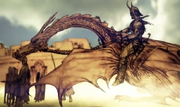
The Valyrians conquered half of the known world, riding their dragons.
The Valyrians created the largest empire the world has ever seen, which lasted for five thousand years, only to be destroyed in a single day when a volcanic cataclysm known as "the Doom" ruined their capital city, four hundred years before the War of the Five Kings. At its height their empire, known as the Valyrian Freehold, encompassed nearly half of the continent of Essos.
Originally a community of shepherds, the Valyrians rose to prominence after discovering dragons in the volcanic area known as the Fourteen Fires. After taming the mighty beasts, they established the city of Valyria and became skilled in both magic and metallurgy - creating a unique type of steel.
With their dragons and weapons, the Valyrians conquered their surrounding lands and began their westward expansion. However, they came into conflict with the Rhoynar as well as the Ghiscari peoples. The Ghiscari Empire fought five wars against the Valyrian Freehold and was eventually defeated, their capital destroyed, and its people enslaved.
For nearly five thousand years, Valyrian hegemony was uncontested, until "the Doom" destroyed much of the Valyrian peninsula. Not only dragons, but also the Valyrians' spells, knowledge and recorded history, were lost.
The cause of the Doom remains unknown, with some believing the Valyrians themselves caused it with their reckless use of magic. In any event, the power of the Valyrians was broken, the ruling dragonlords dead, and soon their colonies throughout Essos declared their independence and a period of constant warfare began: the Century of Blood.
Rhoynar
The Rhoynar were a people from the eastern continent, named for their homeland along the immense Rhoyne River and its numerous tributaries, near the modern Free Cities. One thousand years ago, their territories were conquered by the Valyrian Freehold in a series of massive wars. The survivors fled west across the Narrow Sea and settled in Dorne, where they intermingled with the local population (a mixture of First Men and Andals), giving rise to their descendants, the modern Dornishmen.
Contemporary Cultures and Peoples of Westeros
Descendants of the First Men
Over the millennia, the ancient First Men diversified into several different groups: the Northmen, the Crannogmen, the wildling tribes (or "Free Folk" as they call themselves) who live beyond the Wall, and the hill tribes of the Vale.
Northmen
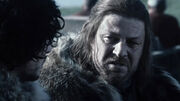
Northmen such as Ned Stark and Jon Snow are descended from the First Men.
The Northmen are the proud descendants of the First Men who dwell in the region of Westeros known as the North, between the isthmus of the Neck and the Wall. When the Andals invaded Westeros six thousand years ago, only the First Men in the North were able to repulse their advance, stubbornly defending the narrow choke point of the Neck at the ancient fortress Moat Cailin.
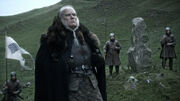
Rodrik Cassel and proud Northern men-at-arms.
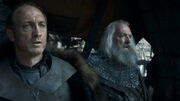
Roose Bolton and Rickard Karstark, Northmen lords.
South of the Neck, the majority of people from the other kingdoms of Westeros are all descended from the Andals, intermixed with the conquered local First Men, but the defiantly independent First Men remained the dominant ethnic group north of the Neck. The blood and traditions of the First Men remain strong in the North to the present day, and belief in the Old Gods of the Forest - worshiped by their First Men forbearers - remains the dominant religion.
For many centuries, the Northmen formed their own independent Kingdom of the North ruled by House Stark of Winterfell, who were known as the Kings in the North (and earlier, the Kings of Winter). Three hundred years ago, however, the Northmen submitted to Aegon the Conqueror during Targaryen Conquest. "The North" became one of the constituent regions of the unified Seven Kingdoms, and the Starks were retained as the Lords Paramount of the North, under the Targaryen kings.
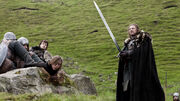
Like their First Men ancestors, the Northmen still believe that the man who passes the sentence must swing the sword.
The years-long winters that Westeros experiences hit the North the hardest. For millennia, the Northmen have also faced raids by wildlings coming over and around the Wall, and sometimes full-scale invasions when the wildlings were united by a King-Beyond-the-Wall. The North also has vast coastlines on both sides of the continent, vulnerable to attack by ironborn on the west coast, and pirates from the Free Cities on the east coast. As a result, Northmen have a reputation for being dour, stern, battle-hardened warriors. With every winter a fight for survival, Northmen take the burden of leadership very seriously as a matter of life and death. As a result, they still firmly believe in the tradition handed down by their First Men ancestors, that the man who passes the sentence of death must personally swing the sword used in the execution. The reasoning is that if a lord is not steadfast enough in his convictions to look a man he has sentenced in the eye and then kill him personally, there will be doubt that the condemned man was guilty.
Northmen are sometimes collectively referred to as "wolves", in reference to the sigil of House Stark. Northmen are also called "Northerners", interchangeably.
Crannogmen

Jojen Reed, a crannogman.
The crannogmen are the inhabitants of the swamps of the Neck, the southernmost part of the North which borders the Riverlands, in central Westeros. They are a unique offshoot of the First Men, who branched off from their Northmen cousins. They are ruled by House Reed as vassals loyal to House Stark. The crannogmen are so-called because they live in small villages in the deep swamps, formed of thatch and woven reeds which sit atop artificial floating islands made out of logs, which are known as crannogs.

Meera Reed of the crannogmen, holding a knife against Osha for threatening her brother.
Hardy and reclusive swamp-dwellers, the crannogmen are derisively referred to by outsiders as "mudmen" and "frog-eaters". They are a poor people, mostly subsisting on fishing and frogging, as well as eating any game they can hunt. By the standards of some of their neighbors their culture is somewhat primitive, but they are very woodcrafty, with great knowledge of their terrain as well as of poisons made by local plants and animals in the swamps, which they often coat their weapons with. Crannogmen are typically short in stature.
The crannogmen are a different offshoot of the First Men, separate from the Northmen who also descend from the First Men. However, the crannogmen do consider themselves to politically be "Northmen", in a general sense, because they have been ruled by the Starks of Winterfell for centuries.
Wildlings (Free Folk)

Tormund, a wildling chieftain.
The "Free Folk" is the name used to refer to themselves by the people who live in the lands beyond the Wall, still on the continent of Westeros but beyond the northern border of the Seven Kingdoms.[4] The name they employ makes reference to their society, which recognizes no political authority and no claim of ownership over the land. The people of the Seven Kingdoms refer to the Free Folk derogatorily as "wildlings".
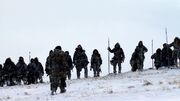
A wildling raiding band.
The Free Folk are descended from the First Men, as are the inhabitants of the North. They were, essentially, the people unlucky enough to be living north of the Wall when it was constructed eight thousand years ago. Besides this shared ethnic heritage, their common descent means that there are also many cultural similarities between the wildlings and the Northmen. The wildlings are much closer in lifestyle and habits to how the First Men lived thousands of years ago, as the North has come under some cultural influence from their Andal neighbors who invaded southern Westeros six thousand years ago, and particularly since the Seven Kingdoms were united into a single realm by the Targaryen Conquest three hundred years ago.[5]

Osha, a wildling who fled south of the Wall.
The Free Folk worship the Old Gods of the Forest, like their distant cousins in the North. Even in the lands of House Stark, there are some followers of the Faith of the Seven, often southern noblewomen who come to the North to secure marriage alliances. Beyond the Wall, however, the Old Gods are the only gods that are worshiped.[6]
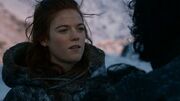
The Free Folk consist of a wide variety of many fractious tribes and village-dwellers, some reasonably refined, others savage and hostile. Different wildling factions have very different cultures and practices, and may speak different languages. They spend much of their time fighting one another over petty squabbles, aside from the times when they are unified by a King-Beyond-the-Wall - as they are now under Mance Rayder.
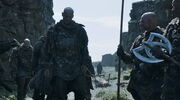
The Thenns are one of the most dangerous wildling clans.
Some of these clans or groups include:
- Numerous clans from the vast Haunted Forest, immediately north of the Wall but east of the Frostfang Mountains. These tend to be semi-nomadic hunters and homesteaders, though some of them form villages of their own.
- Thenns
- Hornfoots
- Ice-river clans
- Cave people
Hill tribes of the Vale
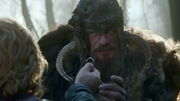
Shagga, son of Dolf, chieftain of the Stone Crows.
The hill tribes (or "mountain clans") are clans who live in the foothills of the Mountains of the Moon on the western fringes of the Vale of Arryn. They reject and resist the rule of House Arryn, and harass travelers along the Eastern Road through the mountains.
They are descendants of the First Men who originally occupied the Vale during the Age of Heroes and before. They were driven into the hill by the Andal invaders.[7]
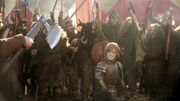
Hill tribesmen hired for war by Tyrion Lannister.
Prominent hill tribes include:
- Stone Crows - led by Shagga
- Burned Men - led by Timett
- Black Ears - led by Chella
- Moon Brothers - led by Ulf
- Painted Dogs
The hill tribes are also sometimes derisively referred to as "wildlings", but out of context the term is usually understood to refer to the peoples living beyond the Wall, who refer to themselves as the "Free Folk" ("wildlings" is used as a generic synonym for "barbarians" or "savages").[8]
Contemporary Andal kingdoms
Valemen

Ser Vardis Egen, a Valeman.
The Vale of Arryn (often known as just "the Vale") was the first region of Westeros that the Andals invaded in their migration to the continent 6,000 years ago, and today the noble Houses of the Vale boast the purest Andal bloodlines. In other regions, the Andals heavily intermarried with the local First Men, so the Lannisters, Tyrells, and Tullys all have at least some First Men ancestry.
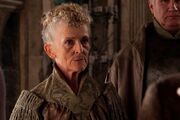
Lady Anya Waynwood, a noblewoman of the Valemen.
The Vale is self-sufficient but not as rich as the Westerlands or as bountiful as the Reach. Their major advantage is their isolation: the Mountains of the Moon along the border prevent any major army from approaching by land, save through a few very narrow and heavily defended mountain passes which can repulse any attack. As a result, Valemen place great pride in their lineages, while maintaining a certain arrogance born of isolation. They may not possess the large armies of the Reach or expensively equipped armies of the Westerlands, but throughout the centuries those armies have broken like water on rock against the narrow choke points of the Vale's mountain passes.
Reachmen

Olenna and Margaery Tyrell, noblewomen of the Reachmen.
The Andals may have begun their invasion in the Vale, but the fertile lands of the Reach soon became their cultural heartland, and remained so for thousands of years. The High Septon, leader of the Faith of the Seven, used to be based in the major city of Oldtown for centuries (until moving to King's Landing about 150 years ago). The Reach is considered the heartland of chivalry in Westeros: the traditions of Knighthood and chivalry are therefore taken very seriously in the Reach, as are associated cultural elements such as Tournaments, as well as courtly love and romantic intrigue. The noble courts of the Reach are the most sophisticated in Westeros.

The customs of knighthood are most important to Reachmen, such as
Ser Loras Tyrell.
The Reach is also the most fertile region of Westeros, meaning that the Reach has the largest population and can field the largest army, nearly twice the size of any other kingdom (though this balances out because the Reach also has twice as many bordering kingdoms as any other). Unlike the other major kingdoms, however, their rulers House Tyrell were never kings, but raised up by the Targaryens as the new regional rulers - ahead of other families in the Reach who actually had better claims to Highgarden. The result is that there has always been a considerable amount of court intrigue in the Reach, and negotiation of marriages to secure political alliances. Reachmen pride themselves on the knightly values of martial prowess and honorable conduct (though of course, this varies from individual to individual).
Westermen
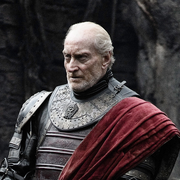
Tywin Lannister, a Westerman.
The Westerlands are very mountainous and by far the richest of the Seven Kingdoms in terms of precious metals and gemstones. Their gold mines enrich the realm, and are famous even far across the Narrow Sea. While Valemen pride themselves on their lineages and isolation, and Reachmen pride themselves on knightly conduct and valor from their large armies, Westermen pragmatically value whoever has the most gold. For thousands of years, the wealthiest family in the Westerlands have been their rulers, House Lannister of Casterly Rock.
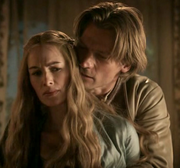
Cersei and Jaime Lannister, Westermen.
Because their kingdom is the richest in precious metals, and also useful metals such as iron, Westermen armies tend to be the best equipped in Westeros, with even their infantry wearing large amounts of plate armor and full-visor helmets (in contrast to the resource-poor Northmen, who often have to make do with chainmail). Because they do not value lineage or knightly conduct so much as they value wealth, Westermen nobles such as the Lannisters have come to be calculating and pragmatic in politics, often defeating their enemies not through valor but simply hiring larger armies.
Stormlanders
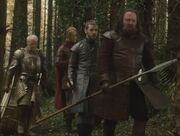
King Robert Baratheon and his younger brother Renly, Stormlanders. Joining them is Ser Barristan Selmy of the Kingsguard, also a Stormlander.
The Stormlands have neither the gold of the Westerlands nor the fertile fields of the Reach - nor do they even have the defensive mountains that protect the Vale from attack by land. As a result, to defend their territories Stormlanders have had to develop the strongest martial tradition of any of the Andal kingdoms. Some of the greatest warriors in the history of the Seven Kingdoms have been Stormlanders, such as Robert Baratheon, who slew Rhaegar Targaryen in single combat during the Battle of the Trident. The warrior-woman Brienne of Tarth is also a Stormlander (though her behavior is unusual even for noblewomen from the Stormlands).
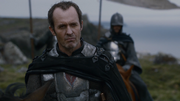
Stannis Baratheon, middle brother of Robert and Renly.
Stormlanders are also often skilled and battle-hardened commanders of armies on land and fleets at sea, such as Robert's younger brother Stannis.
The borderlands in the southwest of the Stormlands are known as the Dornish Marches, because they are along the mountainous border with Dorne to the south, though they have also been contested by the Reach from the west. The Marcher lords of the Stormlands have always been the first line of defense in constant border disputes over the centuries, resulting in them possessing an even stronger martial tradition than the rest of the Stormlands. The living legend Ser Barristan Selmy is a Stormlander from a Marcher House, as is Ser Beric Dondarrion. The champion archer Anguy is also a Stormlander from the Dornish Marches.
Rivermen
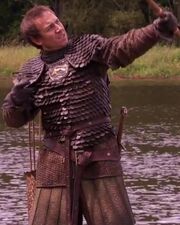
Edmure Tully, new head of House Tully, a Riverman.
Located in the middle of the continent, the Riverlands have long been a contested borderland between the more powerful kingdoms. Before the Targaryen Conquest, the Riverlands were conquered and held by the Stormlands for three centuries. Three generations before the Targaryen Conquest, the Iron Islands in turn drove out the Stormlanders and conquered the Riverlands themselves. When Aegon Targaryen and his sisters invaded Westeros, the Rivermen saw them as liberators from brutal ironborn rule, and assisted them in a popular uprising led by House Tully. For this reason the Riverlands didn't have a king at the time of the invasion, and the Riverlands are not technically counted as one of the "Seven" Kingdoms (instead essentially making up the eighth "kingdom") . However, for administrative purposes, the Riverlands and their rulers are equal to any other region of the realm.
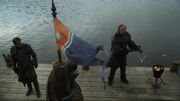
Edmure and his uncle Brynden, Rivermen.
Because the Riverlands had not ruled themselves as a unified independent kingdom for thousands of years, but were border territories which shifted between control of neighboring kingdoms, the Rivermen are more diverse than other Andal kingdoms, with less of a unified identity. House Blackwood and House Bracken loathe each other, and have been feuding for thousands of years. While the other major Rivermen Houses follow the Faith of the Seven, the Blackwoods still worship the Old Gods of the Forest. House Frey is a newer House that rose about six centuries ago by exacting tolls on their bridge crossing, but are looked down upon by the other older Rivermen Houses as greedy and selfish upstarts.
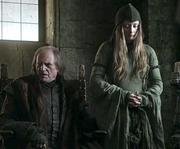
Walder Frey and his new wife Joyeuse, Rivermen.
In the other Andal kingdoms vassal Houses generally try to emulate the lead House, often in clothing styles and manners. Because House Tully never ruled as kings and the Riverlands were not unified for thousands of years, however, some of their vassals see no particular reason why they should be ruled by the Tullys of Riverrun and do not respect them as much (the only comparable situation was with how the Tyrells were raised to rule the Reach despite never being kings, but at least the Reach had been a unified kingdom for thousands of years before that).

"Black Walder" Rivers, of House Frey, a Riverman.
Therefore, there really is no set appearance or clothing style for Rivermen - the Freys in particular dress nothing like the Tullys, instead of emulating them, because they chafed under Tully rule. Different Rivermen Houses can also have very distinct local customs, such as how the Tullys conduct funerals by ceremonially burning their dead on pyre-boats in the Trident River.
Therefore, if the defining characteristics of Reachmen are their fertile fields and chivalry, of Westermen their gold and riches, of Stormlanders their martial prowess, and Valemen their proud lineages and isolation, the defining characteristic of the Rivermen is their diversity.
Crownlanders
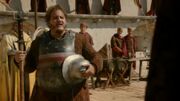
Ser Dontos of House Hollard, a Crownlander.
The Crownlands are the newest region in the Seven Kingdoms, created only three hundred years ago as a result of the Targaryen Conquest, carved out of territory from neighboring kingdoms to make a new capital region. As a result, it does not have much of a distinct "cultural identity", so much as it is shaped by its distinction as the region containing the capital city, King's Landing, which Aegon I Targaryen ordered built there after his conquest.
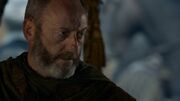
Davos Seaworth, born in King's Landing, though he later moved to the Stormlands.
Culturally and historically, the Crownlands were primarily an extension of the Riverlands for thousands of years, but with cultural influences from neighboring regions which periodically captured territory in the region. The greatest of these was the conquest of all the Riverlands by the Stormlands, which lasted for three centuries. The Stormlanders were ultimately driven out when the ironborn invaded the Riverlands from the west, under Harren Hoare's grandfather. Harren's father then conquered the area of the future Crownlands, though Harren later died during the Targaryen Conquest.

Alliser Thorne, a Crownlander exiled to the Wall.
The Crownlanders are an ethnically disparate mix of former Rivermen, former Stormlanders, holdout First Men, and even some Valyrians, divided into basically five geographic sub-sections: King's Landing itself, the main farmlands north of the Blackwater River and west of Crackclaw Point, the pine barrens of Crackclaw Point, the strip of land on the southern coast of Blacwater Bay running from the Blackwater River to Massey's Hook, and the islands in Blackwater Bay. The main section's rich farmlands feed the capital city, and were originally Rivermen who had long been ruled by the Stormlanders, generally the same First Men/Andal mix as most other regions of the south. Rosby, Duskendale, and Stokeworth are part of this group. Crackclaw Point is a wooded backwater that was rarely held for long by outsiders, and thus has a greater descent from the First Men, though they have intermarried with powerful Andal families over the centuries. The southern strip including Massey's Hook was actually still part of the Stormlands during the Targaryen Conquest, but the Stormlander lords of the region had already developed closer ties to the Targaryens and openly joined them at the beginning of the invasion. These former Stormlanders include House Massey and House Bar Emmon. In Blackwater Bay, the large islands of Dragonstone, Driftmark, and Claw Isle were actually settled by Valyrian families from Essos, the Targaryens, Velaryons, and Celtigars (respectively). These began as Valyrian trading outposts, and later became refuges after the Doom destroyed Valyria.
King's Landing itself, meanwhile, is practically another category unto itself. When the Targaryens built their new capital city from the ground up, it was a boom town quickly populated by artisans, merchants, and commoners who came from all over the rest of the Seven Kingdoms. As the largest port on the east coast of Westeros, a large number of foreigners from the Free Cities and beyond also live in the city (such as the master-blacksmith Tobho Mott, from the Free City of Qohor). Above them all for three hundred years were the Targaryens, who were ethnically Valyrian, though in such small numbers that they did not constitute another demographic group. Due to their presence there is not so much one custom "Crownlander" style of clothing and appearance, so much as local lords and courtiers imitate the fashions set by the royal family. For example, when Eddard Stark arrives at court, most of the ladies at court dress in a style imitating the styles worn by Queen Cersei.
Ironborn
- "We are ironborn. We're not subjects, we're not slaves. We do not plow the field or toil in the mine. We take what is ours."
- ―Balon Greyjoy
In the present day, the Ironborn generally think of their distinct culture as stretching back without interruption to the Dawn Age, long before the Andals arrived. Even back then, however, their culture had developed so differently from their First Men cousins who were on the mainland that the ironborn only consider themselves to have truly "originated", culturally, on the Iron Islands themselves.
Dornishmen: contemporary inhabitants of Dorne
There are actually three kinds of Dornishmen in modern times, one thousand years after the Rhoynar migration to Dorne. "Salty" Dornishmen live near the coasts and in the densely populated river valleys of eastern Dorne. "Sandy" Dornishmen live in the central deserts. "Stony" Dornishmen live in the Red Mountains along the western border.
"Salty" Dornishmen
"Sandy" Dornishmen
"Stony" Dornishmen
Valyrian survivors: The Targaryens and their vassals
Contemporary Cultures and Peoples of Essos
The Nine Free Cities: Daughters of Valyria
Volantenes
Pentoshi
Lysenes
Myrish
Tyroshi
Qohorik
Norvoshi
Lorathi
Braavosi
The modern Ghiscari of Slaver's Bay
Mantari
Dothraki
Lhazareen
Qartheen
Yi Ti and the Further East
Yi Ti is a region located in the far east of Essos. It is located at the eastern limits of known world, beyond the Jade Sea and to the east of even Qarth. It is sometimes mentioned in the same breath as Asshai as an extremely remote part of the world from Westeros[9]. Merchant ships from Yi Ti and Asshai regularly visit Qarth to conduct trade.[10]
People or things from Yi Ti are referred to as "Yi Tish".
- Yi Ti is inspired by China and the Far East from real-life history - though the term consistently used in Westeros for Yi Ti and its neighboring lands is "the Further East", nor "the Far East".
- Elio Garcia and Linda Antonsson, who run Westeros.org and co-wrote the World of Ice and Fire sourcebook with George R.R. Martin, have confirmed this. As Linda put it, "if anyone in the Westeros-Essos continuum looks East Asian, we're talking Yi Ti." Elio said Yi Ti was "definitely inspired by Imperial China," particularly its rule by divine god-emperors.[11] Martin himself also stated in his blog that Yi Ti and surrounding nations are his world's analogue of Far East Asia, and he directly addressed the question of why no East Asian characters figure prominently in the narrative:
- "Well, Westeros is the fantasy analogue of the British Isles in its world, so it is a long long way from the Asia analogue. There weren't a lot of Asians in Yorkish England either. That is not to suggest that such places don't exist, however. You will want to get The World of Ice and Fire when it comes out...in the "Other Places" section you will find a lot of material about Yi Ti, the island of Leng, and the plains of the Jogos Nhai, which you may find of interest."[12]
Asshai
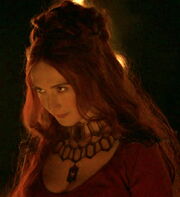
Melisandre of Asshai
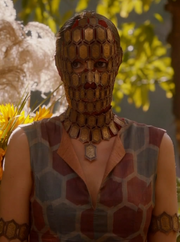
Quaithe of Asshai
Asshai is port city in the far east of the Jade Sea, even further east than Yi Ti. It is so far away from Westeros that it half-legendary to its inhabitants, and infamous as a city of sorcerers, warlocks, and other practitioners of the dark arts. Worst of all are shadowbinders, who alone venture into the neighboring Shadow Lands in the Mountains of the Morn, seeking arcane riches, and relics such as dragonbone. But even the shadowbinders fear to travel further east into the heart of the Shadow Lands, where can be found the strange city of Carcosa, ruled by its Yellow King.
What little is known about Asshai from travelers' reports say that its enormous land walls enclose an area so vast that it could contain King's Landing, Oldtown, Qarth, and Volantis - but its current population is no bigger than that of a large market town. Asshai is located at the mouth of the Ash River, whose waters are poisonous. Absolutely nothing grows in Asshai, except for glowing Ghost grass, which is inedible to anything. All food, and even all basic drinking water, has to be imported to Asshai by foreign merchant ships - in exchange for gold and gems, which Asshai has in abundance. There are no horses, or even wild animals, in the city. Animals such as horses and dogs who are brought to Asshai by ship soon die. There are no children in Asshai. Even the very fumes of the Ash River (or some other malign presence) seems to render people sterile who live there for prolonged periods of time.
The people of Asshai are known as Asshai'i. Because there are no children in Asshai, its culture "reproduces" by purchasing foreign slaves and raising them as the next generation of Asshai'i. As a result, there is no set ethnic appearance for Asshai'i, who could have been born into slavery in the Free Cities, the Summer Islands, or Yi Ti before being taken to the city.
- Only two characters from Asshai have appeared in the novels, Melisandre and Quaithe. Quaithe always wears a mask so her appearance is unclear from the text. Melisandre is described as pale skinned and taller than most men, with unnaturally red hair and matching red irises (her appearance perhaps being enhanced by magic). Melisandre states in both the books and TV series that she was a slave when she was a little girl - she was sold to and raised in Asshai. The actress who plays Melisandre in the TV series is Dutch, and the actress who plays Quaithe is German, but Asshai'i are a culture, not a race, and can potentially be any ethnicity.
Sothoryos
Summer Islanders
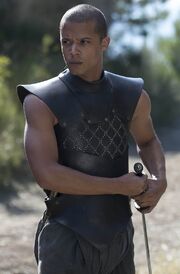
Grey Worm, a Summer Islander taken by slavers as a baby and made into an Unsullied.
The Summer Islands are tropical islands located far west of mainland Sothoryos, west of Naath. They are straight south of the Narrow Sea, and the northernmost is at about the same latitude as Old Valyria.
The Summer Islanders are an ancient and advanced civilization, and Summer Islanders are renowned as great mariners. Their merchant ships can be found in many major cities across the far corners of the globe. Summer Islanders believe that sex is a gift from the gods to humanity and a holy, life-affirming act, for which there should be no shame. Like the peoples of neighboring lands around Sothoryos, they are ethnically quite distinct from the peoples of much of Westeros and Essos, being notably dark-skinned.
Summer Islander sea-captains and merchants can also settle in other lands: the pirate-lord Salladhor Saan lives in the Free City of Lys but is ethnically a Summer Islander (Lys is very close to the Summer Isles), as is Xaro Xhoan Daxos, a Summer Islander who rose to become a powerful magister in Qarth.
The slave Grey Worm is ethnically a Summer Islander but he was taken in a slaving raid as a baby and has no memory of anything before he was forced to become an Unsullied slave-soldier.
- In the books, Salladhor Saan is simply a Lysene, and Xaro is a Qartheen. The TV series cast black actors based on the strength of their performances, so they slightly altered their backstories to say that they were originally from the Summer Islands. Nothing is known about Grey Worm's backstory in the novels, though as a slave-soldier in Astapor it is entirely plausible that he could ethnically be a Summer Islander taken in a slaving raid as a baby.
- The books directly state that because they are prolific sea-traders, Summer Islander crews are commonly encountered in major port cities across both Essos and Westeros, including King's Landing itself. The TV series hasn't had time to prominently show this. A few other more prominent Summer Islander characters actually appear in the novels but were cut from the TV series. While Littlefinger does own several brothels in King's Landing in the novels, the high-class brothel that most highborn characters visit is owned by a Summer Islander madam named Chataya. The TV series changed Chataya's brothel to be Littlefinger's brothel.
Naathi

Missandei, a Naathi.
The Naathi inhabit the island of Naath, located west of mainland Sothoryos, and east of the Summer Islands. As with these neighboring regions, its inhabitants are dark-skinned. The Naathi are are also known as the Peaceful People, because their religion commands utter pacifism. This restriction on violence is so great that they are vegetarians, refusing to kill animals for their meat. Unfortunately, their refusal to engage in martial endeavors even for self-defense has made them a frequent target of slaving raids from Slaver's Bay, which is located to the north across the Summer Sea.
Missandei is a Naathi who was captured in a slaving raid as a child, and brought to the slaver-city of Astapor.
- In the books, apart from being dark-skinned, Naathi are described as having a somewhat flat shape to their faces, and gold-colored irises.
Non-Human Races
White Walkers
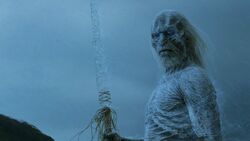
A White Walker.
The White Walkers are a mythological race mentioned in ancient legends and stories from the time of the First Men and the Children of the Forest. Eight thousand years before Robert's Rebellion, a winter known as the Long Night lasted a generation. In the darkness and cold of the Long Night, the White Walkers descended upon Westeros from the farthest north, the polar regions of the Lands of Always Winter. None knew why they came, but they killed all in their path, reanimating the dead as wights to kill the living at their command. Eventually the peoples of Westeros rallied and in a conflict known as the War for the Dawn, they managed to defeat the White Walkers and drive them back into the uttermost north, with the Wall raised to bar their return.
In the present day, most believe they never existed and are just myths, spoken of in the same breath as ghosts, goblins, grumpkins, or snarks. Even the few who believe they did once exist think they went extinct thousands of years ago. Certainly, none were seen for thousands of years after the Long Night.

The White Walkers raise the dead as armies of Wights to kill the living.
Just before the outbreak of the War of the Five Kings, however, disturbing reports began to reach the Night's Watch from the wildlings who live beyond the Wall that the White Walkers had returned. Having enjoyed a decade-long summer, Westeros seemed due for an equally long winter, and the White Walkers seem to be spreading with it. With the Seven Kingdoms embroiled in a petty civil war, the dwindling and under-supported Night's Watch realize that they are all that guards the realms of men against the return of these legendary demons of ice and death.
While having an overall humanoid appearance, White Walkers differ greatly from humans. They are taller than humans and have long wispy white hair. They have pale grey-white skin which is wrinkly but stretched taut across their frames, giving them a somewhat gaunt and mummified appearance despite their overall bulky size. Their most notable trait, however, are their glowing blue eyes.[13][14]
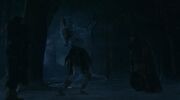
Being stabbed with dragonglass makes White Walkers turn to ice and shatter to pieces.
The White Walkers' one major weakness is that being stabbed with weapons made of Dragonglass (obsidian) will make their bodies instantly freeze and shatter like ice until there is nothing left but powder. Meanwhile, dead creatures they have reanimated as wights are very vulnerable to fire: if exposed to even a small amount of flame, they will instantly catch fire and quickly burn away to ashes.
- In the novels, the term "White Walkers" is an alternate name for the race of beings much more commonly called "the Others" (always with a capital "O"). The TV series exclusively refers to them as "White Walkers". The TV producers later stated in the Season 1 Blu-ray commentary that the change was to avoid viewer confusion between the specific name "Others" and the generic use of the term: book-readers can tell that "Others" is treated as a capitalized proper noun, but TV-viewers cannot. It sounded like actors saying, "He says he saw the others" - "other soldiers"?, "other horses"? - so the term was just too confusing in the audio-visual medium of television.
- The appearance of the White Walkers in the TV series matches the general description in the books that they are tall and gaunt with pale white skin and glowing blue eyes. However, Martin has explained to illustrators that they are inhumanly beautiful and elegant, somewhat like the Sidhe (Faeries from Irish myth) if made of ice (not that the White Walkers are actually made of ice). They somewhat resemble depictions of beautiful vampires, but ice-themed. Martin has also stated that the White Walkers are not "dead" the way their wights are, but they are not just a different kind of species: they are "another sort of life". The TV producers either thought that this was too Elf-like or too difficult to accurately depict on-screen, so they instead interpreted the White Walkers' appearance as more mummified.
Giants
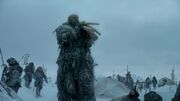
Giants are a non-human race that still live beyond the Wall.
Giants are a non-human race considered to be a legend by the inhabitants of the Seven Kingdoms south of the Wall. However, giants do actually exist in the furthest north beyond the Wall, and have had some interactions with the human wildlings. This is in contrast with both the Children of the Forest and the White Walkers, which even the wildlings claim to have not seen in thousands of years. Giants were even convinced to join with the wildling army led by King-Beyond-the-Wall Mance Rayder. Giants lived in Westeros before the coming of the First Men 12,000 years ago, along with the Children of the Forest, but like they Children they were pushed out by human migrations, and now the few remaining giants live in the remove tundras far north of the Wall.
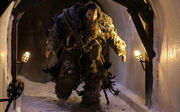
Mag the Mighty, a leader of the giants.
Giants are over twice as tall as a man, and very strong. They have blocky facial features, and their clothing tends to be an odd mix of various fabrics, skins, and rope which they wrap around themselves, haphazardly adding more as they acquire it.
Giants have managed to tame mammoths, and they ride them as massive beasts of war.
- In the novels, giants have a drastically different, more ape-like appearance. They tend to be about twice as large as a very tall human, about 12 to 14 feet in height, but not monstrously huge. A single giant is as strong as a dozen humans.
- They generally resemble descriptions of the Sasquatch (Bigfoot) or Yeti. They wear no clothing, but instead are covered in shaggy fur pelts, which are thicker below the waist. The fur of older giants becomes grey and streaked with white. Their heads are thrust forward from their shoulder blades but they have very short necks. They have squashed-in faces with square teeth and tiny eyes amidst folds of flesh. Their eyesight is poor and they snuffle constantly, smelling as much as they see.
- They have sloped chests, and their lower torsos are about half again as wide as their upper torsos. Their arms hang lower than a man's, while their legs are shorter than their arms, ending in splayed feet that need no shoes even in the coldest weather. The female giants look similar to the men.
- The giants in the novels are therefore so inhuman that they do not correspond to any human ethnicity. The TV-version of the giants is more human-like, and the two giant characters who appeared by the end of Season 4 were played by caucasian actors - but they are wearing a lot of prosthetic makeup to make their faces appear very blocky, so they probably don't correspond to any human ethnicity.
Children of the Forest

Leaf, one of the non-human Children of the Forest.
The Children of the Forest are a mysterious non-human race that were reportedly the original inhabitants of the continent of Westeros. They were already living in Westeros when the First Men migrated to the continent, 12,000 years before Robert's Rebellion.[15]
The Children of the Forest were said to be humanoid, but when grown to manhood they were no taller than human children. They generally preferred to live in the depths of the forests in hidden villages, in crannogs of the swamps, or in caves. Thus they came to be known as "the Children of the Forest".
The Children were said to wield magical powers, particularly by their wise-men known as Greenseers. When the First Men migrated to Westeros they warred with them for centuries before coming to a peace with them known as "The Pact", after which they were at peace for millennia. During the Long Night 8,000 years ago, the Children aided the First Men to drive back the White Walkers, and according to legend, helped build and strengthen the Wall with magical spells to prevent the White Walkers from crossing it.
There were never many Children to begin with and they took heavy losses fighting the White Walkers from which they never truly recovered. When the Andals invaded Westeros 6,000 years ago, they overwhelmed and slaughtered the few remaining Children. According to legend, a handful of the Children fled north of the Wall, where they knew the Andals would not follow them. In the present day, most believe that they are simply the stuff of myth and never existed at all. Even the few that do believe they once existed, such as Maester Luwin or Ned Stark, believe that they have long since gone extinct.
In truth, a small number of the Children of the Forest actually did survive in hiding beyond the Wall. Bran Stark was guided to the cave system they were hiding in by visions from the Three-eyed raven - really, the Last Greenseer, a human man being attended on by the remaining Children of the Forest .
- Although they occupy the position usually filled by Elves in other high fantasy media, George R.R. Martin has repeatedly insisted that the Children of the Forest are not simply his version of Elves, because "Elves have been done to death". While the Children are repeatedly described as "dark and beautiful" this is not in the same manner of Tolkien's Elves: the Children are described as being smaller than humans with nut-brown skin (dappled like a deer but with paler spots), large ears, and glowing gold eyes, slitted like a cat's. They also have 4 digit hands (3 fingers and a thumb) that end in small claws instead of primate fingernails. The Children did not weave cloth for garments, but wore shorts of woven leaves, and leg-bindings made of tree bark. They interwove vines and flowers into their hair.
- Artistic depictions of the Children of the Forest in the "Complete Guide to Westeros" Season 1 Blu-ray featurettes depict them as nothing like stereotypical Elves, who usually inhabit graceful castles and are highly "civilized". Instead, the Children are depicted as being an aboriginal people adorned with totems and tattoos.
Another of the Children, played by an asian actress.
- When the Children of the Forest finally appeared in the Season 4 finale of the TV series, they were played by child actors. They apparently don't have claws instead of fingernails - and appear with five fingers instead of four, contradicting both the books and artwork from the Blu-ray featurettes. This is probably due to the budgetary constraints of a television adaptation: accurately depicting the Children as they appear in the novels would require expensive motion-capture CGI, similar to the Na'vi in James Cameron's Avatar. The TV-Children of the Forest might actually have dappled skin as in the books - it isn't clear in the Season 4 finale if Leaf is wearing leggings, or if the alternating black and white markings are her actual skin color.
- The Children of the Forest in the novels, therefore, appear so inhuman that they do not really resemble any human ethnicity. The TV series, however, uses child actors with minimal makeup - raising the issue of what human ethnicities are actually being used to portray the Children. The actress who played Leaf in the Season 4 finale is Romanian. This does not, however, mean that all Children of the Forest are automatically caucasians. Another of the Children also appeared in the cave in the Season 4 finale, however, played by ethnically Chinese actress Alice Hewkin. Therefore, it seems that in the TV continuity actors of any ethnicity could plausibly play Children of the Forest.
References
- ↑ "Complete Guide to Westeros"
- ↑ 2.0 2.1 HBO Viewer's Guide, Season 2 appendices Westeros Through the Ages
- ↑ Note: "ironborn" is consistently spelled with a lowercase "i", except when it is the first word in a sentence.
- ↑ "The Old Gods and the New"
- ↑ "A Man Without Honor"
- ↑ "The Pointy End"
- ↑ Game of Thrones Season 4: Episode #5 - Know Your Strengths (HBO), directly stated by George R.R. Martin.
- ↑ "Baelor"
- ↑ Inside HBO's Game of Thrones, Section V, Essos:A Brief History
- ↑ Complete Guide to Westeros - Qarth
- ↑ Westeros.org Season 5 casting review
- ↑ Not A Blog, GRRM's livejournal, June 14th, 2014
- ↑ "Valar Morghulis"
- ↑ "Second Sons"
- ↑ HBO viewers guide, season 2 Appendix, Westeros Through the Ages
Template:Peoples
